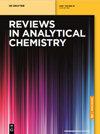食品基质中霉菌毒素展霉素分析方法综述
IF 3.8
3区 化学
Q2 CHEMISTRY, ANALYTICAL
引用次数: 14
摘要
摘要:本文对现有文献报道的食品基质中痕量/超痕量霉菌毒素棒曲霉素的分析方法进行了综述。这篇文章开始关注霉菌毒素是什么,它们的“分析历史”(Scopus数据库中发表了21,000多篇文章):每种霉菌毒素都是特定于特定真菌的,并显示出毒性作用,有些甚至是致癌的。还报告了大多数关于真菌毒素的国际法规,这些法规涉及食品链中的官方控制措施以及真菌毒素的抽样方法和最大可耐受限度。然后,手稿集中在展霉素,一种真菌毒素,主要是由真菌物种青霉菌扩张产生。本文讨论了展霉素的主要特征和性质,包括展霉素的生物合成,特别是对受展芽孢杆菌及其衍生物侵染的贮藏果实的生物合成,展霉素的毒理学,以及预防和减少展芽孢杆菌存在的一些策略。对展青霉素分析程序的描述从取样开始:所报道的提取和分析方法依据官方分析化学家协会的官方规程,该规程依赖于高效液相色谱-紫外/二极管阵列检测器(HPLC-UV/DAD)。此外,还深入讨论了最合适的分析方法。第一个分析步骤是从样品中提取分析物,然后是清理阶段,最后进行定量测定。最后一节分为参考或确认方法、快速筛选和新方法和预期结果,即定性、定量或半定量。参考方法包括薄层色谱法、气相色谱法、高效液相色谱法和质谱法,而快速方法包括酶免疫测定法、试纸和侧流试验。新的分析方法包括荧光、近红外光谱、毛细管电泳和生物传感器。最后,将官方方法与文献中允许多目标分析的其他方法进行比较,并讨论了其与其他分子印迹聚合物技术的结合使用。本文章由计算机程序翻译,如有差异,请以英文原文为准。
Critical review of the analytical methods for determining the mycotoxin patulin in food matrices
Abstract This manuscript is a critical review of the analytical methods reported in the existing literature for the determination of mycotoxin patulin at trace/ultra-trace levels in food matrices. The article starts focusing on what mycotoxins are, their “analytical history” (more than 21,000 articles published in Scopus database): each mycotoxin is specific for a given fungus and shows toxic effects, some even being carcinogenic. Most International regulations on mycotoxins are also reported, which pertain official controls in the food chain as well as the sampling methods and the maximum tolerable limits of mycotoxins. Then the manuscript is focused on patulin, a mycotoxin that is mainly produced by the fungal species Penicillium expansum. The main characteristics and properties of patulin are discussed, including its biosynthesis, especially on stored fruits infected by P. expansum and derived products, its toxicology, and some strategies aiming at preventing and/or reducing its presence. The description of the analytical procedure for patulin starts from sampling: the extraction and analytical methods reported are based on the official protocol of the Association of Official Analytical Chemists, which relies on the high-performance liquid chromatography-ultraviolet/diode array detector (HPLC-UV/DAD). Furthermore, an in-depth discussion of the most suitable analytical methods is reported. The first analytical step regards the analyte(s) extraction from the sample, followed by a clean-up phase, and by a final quantitative determination. This last section is divided into reference or confirmation methods, rapid screening and new methods and expected results, i.e., qualitative, quantitative, or semi-quantitative. Reference methods include TLC, GC, HPLC, and MS, whereas rapid methods include enzyme immunoassay tests, dipsticks, and lateral flow tests. Novel analytical methods include fluorescence, near infrared spectroscopy, capillary electrophoresis, and biosensors. Finally, the official method is compared with others present in the literature allowing a multi-target analysis, and its use in combination with other techniques of molecularly imprinted polymers is discussed.
求助全文
通过发布文献求助,成功后即可免费获取论文全文。
去求助
来源期刊

Reviews in Analytical Chemistry
化学-分析化学
CiteScore
7.50
自引率
0.00%
发文量
15
审稿时长
>12 weeks
期刊介绍:
Reviews in Analytical Chemistry publishes authoritative reviews by leading experts in the dynamic field of chemical analysis. The subjects can encompass all branches of modern analytical chemistry such as spectroscopy, chromatography, mass spectrometry, electrochemistry and trace analysis and their applications to areas such as environmental control, pharmaceutical industry, automation and other relevant areas. Review articles bring the expert up to date in a concise manner and provide researchers an overview of new techniques and methods.
 求助内容:
求助内容: 应助结果提醒方式:
应助结果提醒方式:


